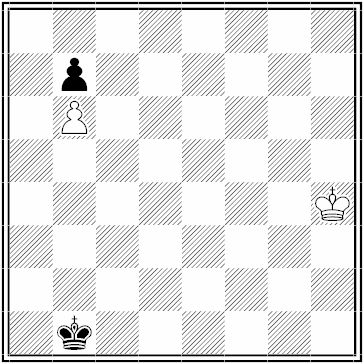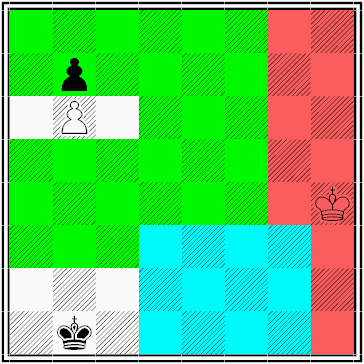Back to the basics
Today I quit working on chapter 7 of SOPE.
Chapter 7 is about 4-6 pawns at one wing.
These problems are far too complicated.
So I decided to go back to chapter 2: king+pawn vs king+pawn (inspired by Montse).
In an earlier post I complained about the habit of composers to choose the most beautiful and hence the most exotic positions.
I will show you what I mean by this. You will be interested in my findings (at least I was:)
Have a look at diagram 1, part of a study by Grigoriev, used for explanation by SOPE.
diagram 1

White to move and draw.
There is only one move for white.
The diagram is given with a lot of variants.
That is not enough to get a thorough insight of the position.
I explored the position with my Nalimov tablebase and this is what I found:
diagram 2.

White to move and draw.
red = white is lost
blue = draw
green = white wins
From this picture it is easy to see why the study of Grigoriev is a special and not a common position.
The use of colored zones gives a much more common and a much clearer picture of what's going on in this position.
In the green area white can conquer the black pawn.
In the blue area white is in time to conquer keysquare b4 at the moment black snacks the white pawn.
Actually I hoped SOPE would do this work for me.
But it seems I have to do it myself.
Away with the beauty, come on clarity:)
Chapter 7 is about 4-6 pawns at one wing.
These problems are far too complicated.
So I decided to go back to chapter 2: king+pawn vs king+pawn (inspired by Montse).
In an earlier post I complained about the habit of composers to choose the most beautiful and hence the most exotic positions.
I will show you what I mean by this. You will be interested in my findings (at least I was:)
Have a look at diagram 1, part of a study by Grigoriev, used for explanation by SOPE.
diagram 1

White to move and draw.
There is only one move for white.
The diagram is given with a lot of variants.
That is not enough to get a thorough insight of the position.
I explored the position with my Nalimov tablebase and this is what I found:
diagram 2.

White to move and draw.
red = white is lost
blue = draw
green = white wins
From this picture it is easy to see why the study of Grigoriev is a special and not a common position.
The use of colored zones gives a much more common and a much clearer picture of what's going on in this position.
In the green area white can conquer the black pawn.
In the blue area white is in time to conquer keysquare b4 at the moment black snacks the white pawn.
Actually I hoped SOPE would do this work for me.
But it seems I have to do it myself.
Away with the beauty, come on clarity:)
This is one tough problem, and yet it looks so easy.
ReplyDeleteIf both players miss the subtleties of the position, they are inclined to think the position is simple. How often have you heard someone saying "this is a dead draw" after just counting the material?
ReplyDeleteIn a next post I will try to "decompose" the compositon further.
That will not be an easy task.
The grail is to find a method that cuts down on calculation.
The tree of analysis for this seemingly simple position allready contains 5 branches and 40+ leaves. This means that without a method that simplifies matters, I will not be able to calculate cases with more than 2 pawns correctly in limited time.